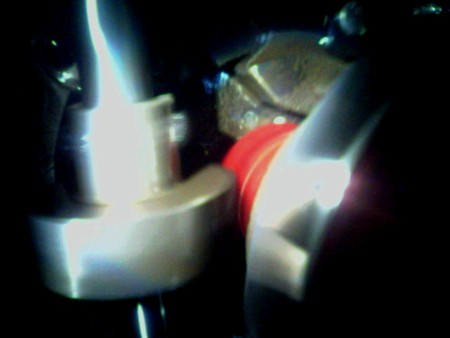|
|
This topic comprises 2 pages: 1 2
|
|
Author
|
Topic: Aside from lack of oil, what could cause the intermittent to fail on a Simplex 1050?
|
|
|
|
|
|
|
|
|
|
|
|
|
|
|
Monte L Fullmer
Film God

Posts: 8367
From: Nampa, Idaho, USA
Registered: Nov 2004
|
 posted 01-12-2009 09:46 PM
posted 01-12-2009 09:46 PM




quote: Jonathan Althaus
The first thing that comes to my mind is, wow only 12 yrs old? 12 of our models are 1989 and the other 3 are 91's. Been here 2 yrs now, no problems with the actual Simplex's.
Mine are the same vintage: May and Aug of '89 along with some PR-1014's of 1994 and both experienced this problem that I brought up and had to adjust that stop allen screw for proper shoe/sprocket clearance - what this screw actually sets - where you make the band adustments with the tension knob.
I cheated and used long needlenose pliers to tweak that stop allen screw, thus I could keep the trap mounted with just removing the gate to make my adjustment.
If you got a screw that doesn't set, you could take the screw out and slightly 'mike' the threads so it will grab on to the threads inside the trap.
What happened with me is that one machine, on startup, would rattle horribly and sounded like a train engine chugging away from the depot til it ramped up to speed. I did the same - took out the INT assembly, yet I could easily spin the flywheel with no problems. After reinstalling the assembly and doing the sprocket alignment with the gate shoes, is where I noticed how the gate was closing too tightly. Thus, sorry if I misunderstood the original question, for I automatically took it as this overtension by the trap and gate assembly.
.................................................................
When you took the assembly out, were you able to turn the flywheel by hand real easily?
One thing you could also check to see if the drain tube on the end of the funnel is inbetween the flywheel and INT casing. For the oil actually gathers in that little "U' shaped galley inbetween the flywheel and the driven and drive gear, and the gear shaft has a spiral that is cut in where this spiral actually "feeds" the oil to go inside the INT case..to oil the starwheel and cam.
With the "FRAME" knob where you can read it normally, the rear of the INT case above the driven gear has two little holes where the oil exits after being fed in by that gear shaft. The main goal is to see oil gushing out of these two small holes during operation. Thus, you know that the assembly is being oiled ... and why I fully maintain that the "FRAME" knob is at this readable position so the INT assembly is getting the best oiling.
-Monte
| IP: Logged
|
|
|
|
|
|
|
|
|
|
|
|
|
|
|
|
|
|
All times are Central (GMT -6:00)
|
This topic comprises 2 pages: 1 2
|
Powered by Infopop Corporation
UBB.classicTM
6.3.1.2
The Film-Tech Forums are designed for various members related to the cinema industry to express their opinions, viewpoints and testimonials on various products, services and events based upon speculation, personal knowledge and factual information through use, therefore all views represented here allow no liability upon the publishers of this web site and the owners of said views assume no liability for any ill will resulting from these postings. The posts made here are for educational as well as entertainment purposes and as such anyone viewing this portion of the website must accept these views as statements of the author of that opinion
and agrees to release the authors from any and all liability.
|

 Home
Home
 Products
Products
 Store
Store
 Forum
Forum
 Warehouse
Warehouse
 Contact Us
Contact Us




 Printer-friendly view of this topic
Printer-friendly view of this topic










![[Eek!]](eek.gif)
![[eyes]](graemlins/eyes.gif)

![[Razz]](tongue.gif) )
)





